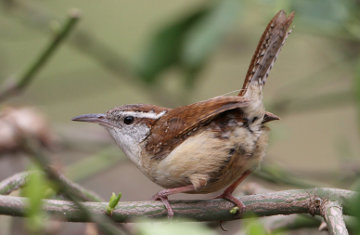Village News

PHOTO COURTESY OF GARRY KESSLER
Carolina wren
October 16, 2020, Page A3
NATURE NOTES
By Annie Reid
Westborough Community Land Trust
A loud little songbird
Birdsong is scarce on autumn days, even as migrating flocks pass through making a racket with their calls and other sounds, but one little bird sings so loudly that you might think it’s shouting from its perch on a wire or branch. It’s the Carolina wren, a year-round resident in Massachusetts that established itself here only in the last century. They don’t migrate.
The Carolina wren (Thryothorus ludovicianus) is small and lively. Male and female look alike, camouflaged in rusty, cinnamon, and buffy browns. You might recognize this wren by its bright white eyebrow stripe and cocked tail. These little birds forage in thickets, tangles, and on the ground, but they also come to feeders, especially for suet in the winter.
You’re likely to be alerted to a Carolina wren’s presence by its loud song, which males sing all year long. They have an average of 32 different songs. The “tea-kettle” song is often described as a fast “teakettle-teakettle-teakettle”. (https://bit.ly/33TKrC1)
You might also hear a female join in at the end of her mate’s song with a kind of rattle that overlaps his in a kind of duet. There’s also a purring sound that can tip you off to look for a Carolina wren.
Carolina wrens pair up for life. A pair establishes a territory where they forage year-round and also nest during the breeding season. Singing is key in proclaiming and defending their territory. You might hear neighboring males singing back and forth, matching and switching songs. Researchers have found that one male can often judge how far away another one is by how well he hears the other singing a familiar song.
Plenty of Carolina wrens seem to be around this year, but that’s not always the case. They are sensitive to cold and don’t do well below about 10 degrees Fahrenheit. They also tend to starve when ice and deep snow prevent them from foraging in low brush and on the ground.
Remember the hard, snowy winter of 2015? Carolina wrens were scarce in our area for two years afterwards. By now, the local population has mostly recovered.
It’s no surprise that the Carolina wren is the state bird of South Carolina. It has long been abundant in southern states. These wrens have been expanding their range northward and westward for more than a century. One was first recorded in Massachusetts in 1901.
What has brought this bird north? The warming climate, leading to warmer winters, is one influence. Another is the re-growth of forests in Massachusetts after the agriculture of the 1800s declined. Finally, the increased popularity of birdfeeders, especially during the winter, may have helped. Other birds that have moved northward to our area, thanks to the same influences, include the tufted titmouse, northern mockingbird, and red-bellied woodpecker.
If the coming winter isn’t a harsh one, keep an eye out next spring for nesting Carolina wrens. They make a bulky cup nest, usually with a dome and a side entrance, in a hollow. The nest is usually placed lower than 10 feet. You might even find a nest in a flowerpot. Enjoy!
Date index
Month (October)
Common name index
Scientific name index
Category index